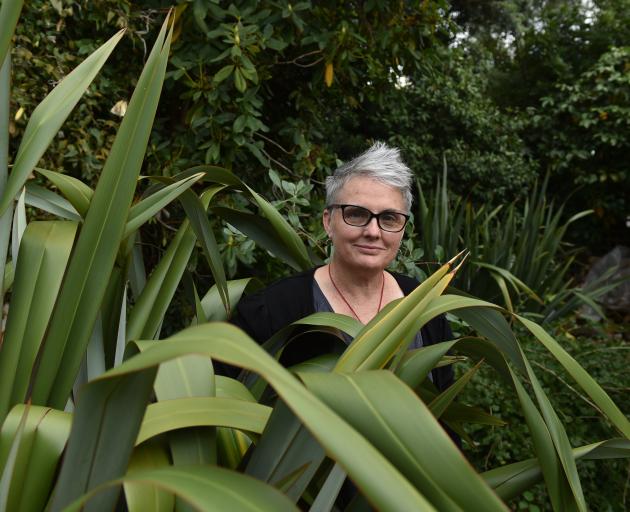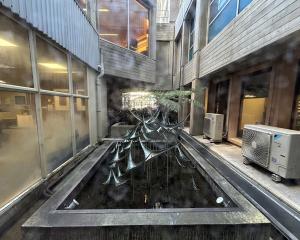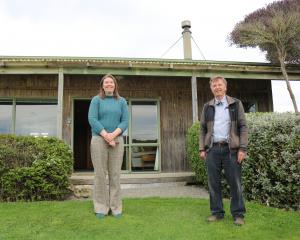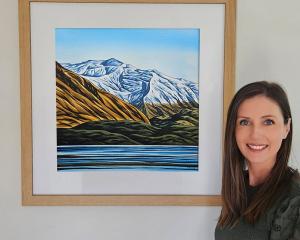
Woven flax sculptures and a cake made from shapewear are worlds apart, yet together they show how diverse New Zealand’s textile art is.
That diversity has been on show in Nelson as part of "Changing Threads", the country’s top textile awards.
The awards encourage contemporary fibre and textile artists to "explore a variety of possibilities, pushing pre-conceived ideas of the limits of the medium".
Dunedin artists Kari Morseth and Victoria McIntosh’s works were selected from 135 to go on show alongside 47 others.
On the judging panel was another Dunedinite, artist Lynne Taylor, who works at the Dunedin School of Art textile and print department.
"I made a beeline for Kari and Victoria’s work and they did not disappoint."

Taylor says the works show "incredible technical accomplishment in the raranga and coloration of the harakeke and muka, the fibres glow".
"The paradox of creating vessels that are very aesthetically appealing to express contemporary issues that we might not want to look at is very poignant. Especially powerful is the unexpected material inclusion of the little soy sauce plastic fish containers. The everydayness of these containers imbues personal reflection on actions and a reminder of responsibility towards ocean pollution and acidification."
They are part of a new body of work Morseth has been working on since making the commitment to pursue her art.
That decision came after the death of a "dear friend" two years ago, which made her think about her priorities.
"If I love doing it so much then I should spend the time doing it."
Over the years, while she has always made art — starting out working with paper and print making — most of her work has involved helping other artists present their work.
About 12 years ago she got a certificate in Maori weaving and discovered a love for harakeke weaving and continued to further her education and knowledge in it when she could.
"But I’ve always been balancing it with my other paid work."
While she started out making kete, her work over recent years has become more sculptural.

"I wanted to do installations because of the nature of my work. I did an installation for the 2017 Fringe Festival which was the impetus to doing more of my sculptural pieces."
A year ago she changed to working 20 hours a week and spending the rest of the time in her studio weaving.
Putting the time into her art work has reaped rewards as she won the 2019 Taranaki National Art fibre award and got a special mention at the last Cleveland Art Awards.
"That was very cool. It’s nice to get the recognition."
Harakeke weaving is not often seen in exhibitions a lot as it is put into the craft category, but is increasingly being seen in contemporary art awards further north, she said.
"I see myself as a craft artist. The fabulous thing about Changing Threads and the Taranaki awards is they recognise fibre as a category and is really open to any fibre which is amazing, including synthetic fibre."
The attraction of weaving for Morseth is working with her hands and the organic nature of harakeke. She likes to combine natural materials and found objects like the soy sauce containers.
"It’s very challenging in that it first appears to some people as being repetitive. There is really a meditative quality to it and mathematical challenges to it.
"I’ve just undone something for the fifth time and I’m re-doing it as I’m still working on my numbers. It’s fine once you work it out."
It took some time to find the right technique to create the circular pieces for this exhibition.

Harakeke is very malleable to a point and is able to take on shapes with a bit of encouragement, she said.
"You have to have a respect for its limits. It’s a very forgiving fibre. I like more sculptural organic shapes. It’s very tactile for me, it kind of becomes all consuming."
She gets her harakeke from the gardens around her house which have become home to 10 different varieties rescued from a Dunedin Botanic Garden collection when they were replanting. Different plants have different qualities, enabling her to select what would work best for each piece.
There is quite a process involved to prepare the harekeke for weaving, including dying it when the design needs it.
"You can get a bit impatient when you first learn to weave. It’s what people don’t see."
She used a black commercial dye for these works, finding the way it takes to the flax can split a little bit creating a "lovely nuance".
"I try not to get to worried about exactness. I like to see how things develop beyond what I originally envisaged. I try and let that be part of it."
Exactness is what is needed by artist Victoria McIntosh in creating her textile "cakes".
For "Changing Threads" she entered The First Slice Won't Hurt at All, a detailed cake sculpture made from discarded undergarments.

"An object offering unobtainable delight mitigating both pathos and humour. This is a memorable work which tickles at inner perceptions, things that have been written on our bodies and things that we might find disturbing," Taylor wrote in her judging notes.
The "cake" works are a development of McIntosh’s jewellery or worn object pieces she has made in the past, such as handbags incorporating vintage and modern shapewear she finds at opportunity shops.
"The different textures and knits in modern shapewear is fabulous."
In 2014 she first became fascinated by the "limitless array" of man-made fibres in every shade of beige.
"I am equally fascinated as I am repelled by these pieces that are literally designed to control the body. With elasticated waist bands and reinforced support panels, they promise to mould and shape you into whatever happens to be the socially acceptable silhouette of the time."
Her cakes incorporate her love of collecting things, as the base layers of all her cakes are found items of different shapes and sizes like jelly moulds.
"It’s taken a lot of collecting, starting years before. It’s changed what I look at collecting. I always look at the free box at op shops as there’s often a lot of random plastic shapes in there."
She has also discovered her own recycling is often a great source too.
"I saw a hummus lid and thought the curve of that is the right size."
What she finds often guides the overall composition of the "cakes". So far she has made five.

She finds creating the cakes to be quite a playful process, reminding her of building with blocks as a child.
"I do like using humour in my work. It’s a way of drawing people into conversations that it is not easy to have. Humour is great in many ways."
Once she has the structure she selects the fabric to cover it, pulling it tight and stitching it on.
"It’s a play on this fabric which is meant to hold you in, squeeze you in, make you look the right kind of shape, continuing that theme around body image but trying to keep it playful as well as serious."
She then details the "icing" design using sewing skills learnt from her grandmother, often bringing in upholstery trims as decoration — another play on words used to describe body image such as well-upholstered.
"My jeweller’s eye for detail is handy. I’m used to working small. I love for them to be well executed. When you are using found things you need for them to be convincing."
Inspiration came from a dessert image from 19th-century English household management expert Mrs Beeton that has been on her wall in her studio for years.
"I had this idea somehow I’d like to re-create them."
McIntosh trained as a jeweller but sees her work moving more towards textile sculpture, although said it was hard to define.
"I still love that hard material. It’s nice to swap between the very soft and hard and finding a way to bring them together which I’ve been trying to do for a long time — this is probably my most successful attempt at doing that."
She enjoys making the cakes and creating items that are quite beautiful but terrifying too.
"I like playing with those ideas of consumption and marketing comes into it to."
There were still many more cakes to make, she said.













